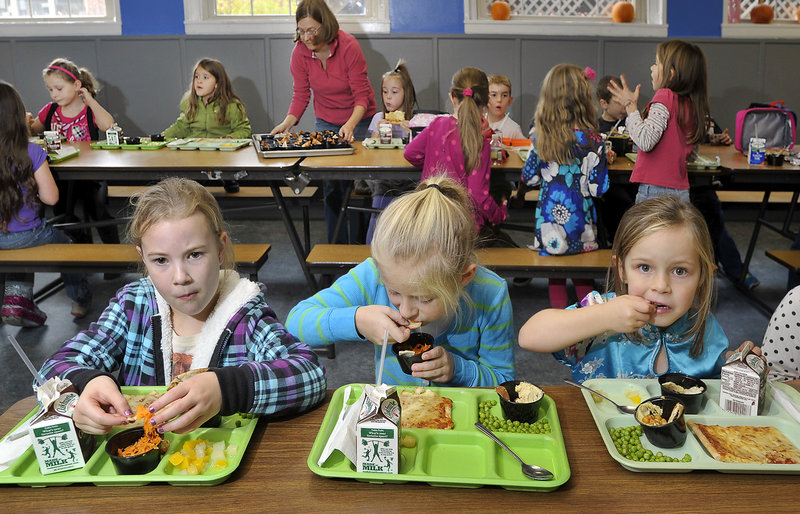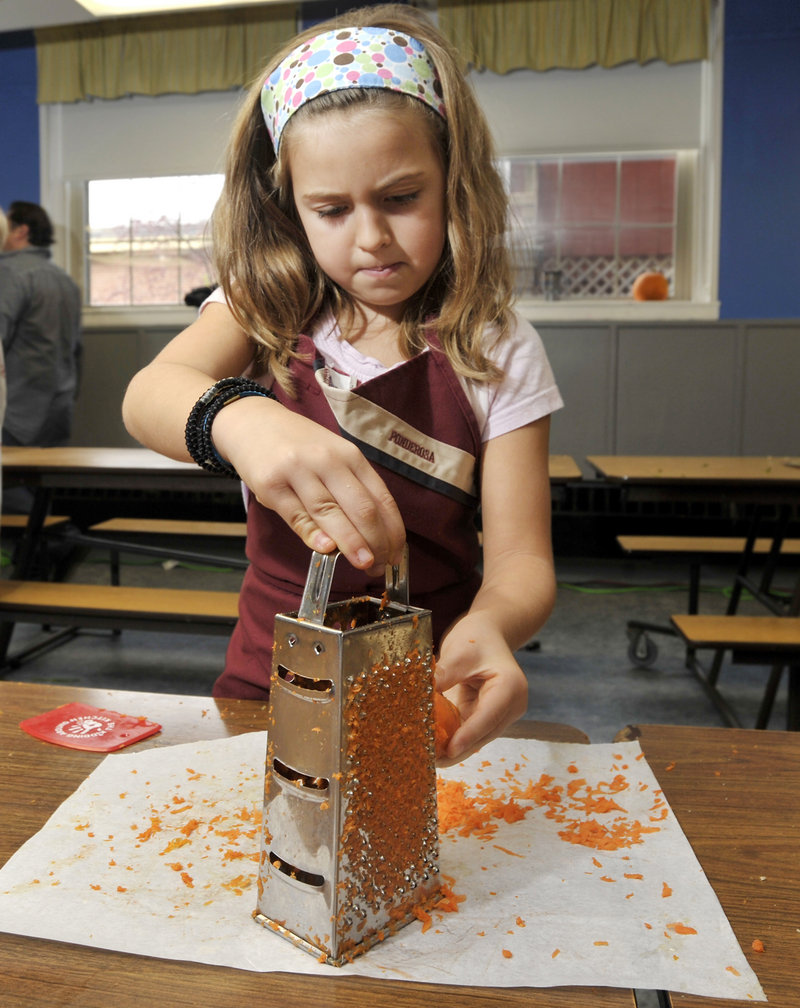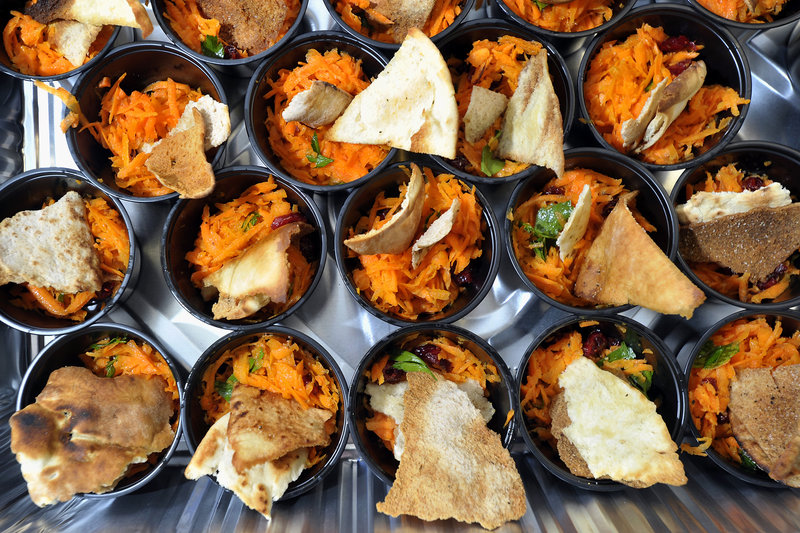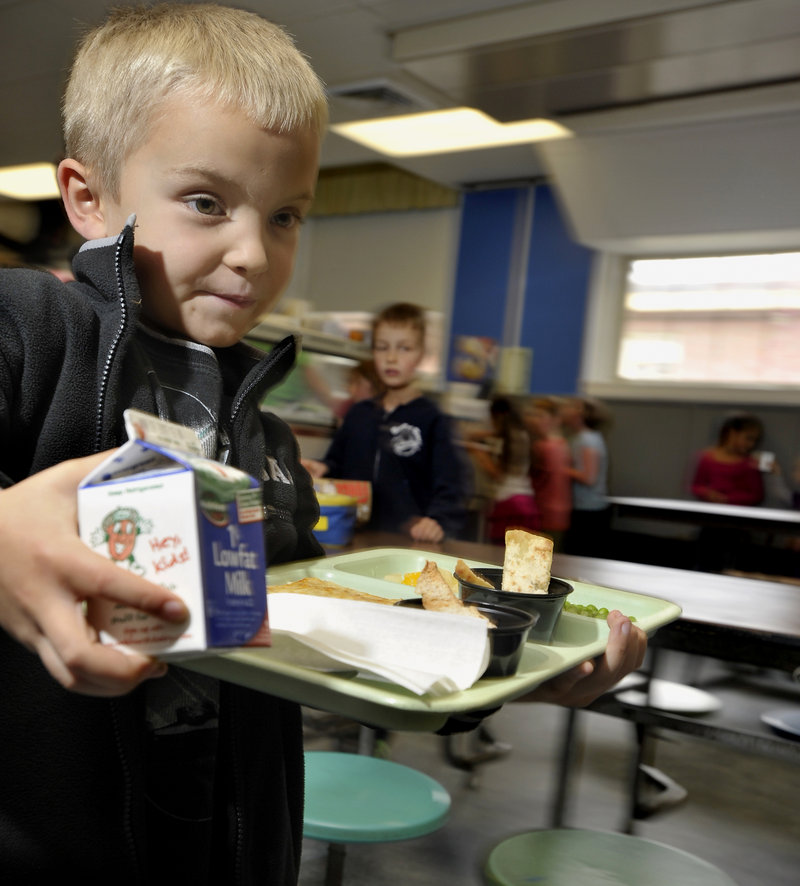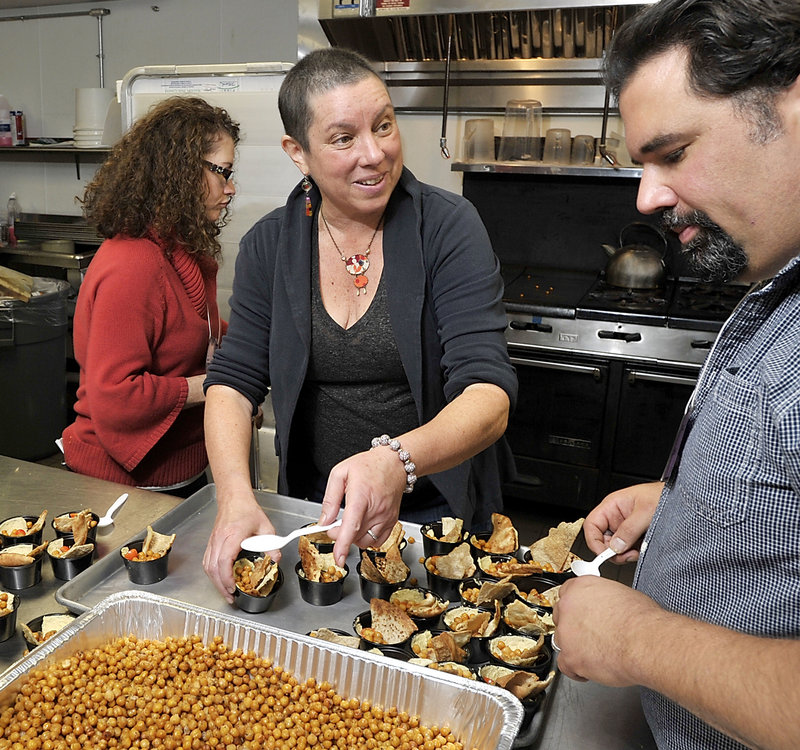Before starting a hands-on cooking lesson with 70 children at South Berwick Central School, chef and prolific cookbook author Kathy Gunst laid down two ground rules: the students had to taste everything, and while they didn’t have to like it all, they couldn’t say “gross” or “yuck.”
As the first- and second-graders, under the watchful eyes of teachers and 18 parent volunteers, intently grated carrots, squeezed lemons and measured ingredients for hummus, carrot slaw, roasted chickpeas and baked pita chips, there wasn’t much danger that such negative culinary reviews would emerge.
Most students seemed inclined to agree with first-grader Camden Marcotte, who pronounced the resulting food “super, duper, duper good.”
Gunst is happy, but not surprised, by such reactions. Involving children in cooking makes them more open to trying new things and more likely to enjoy them, Gunst said.
“What we’ve proven here is that kids will eat practically anything,” Gunst said. “We have to stop calling kids picky eaters. Instead, I say, ‘You don’t like that?’ You will when you’re a year older. Why would you want to set up a kid not to like something?”
Hummus and carrots may be fairly common kid fare, but Gunst, whose latest cookbook is “Notes from a Maine Kitchen,” pointed out that last year she had the budding chefs raving about kale chips and Swiss chard tacos.
The lesson Gunst offered on Nov. 2 was part of an ongoing effort at the elementary school to integrate whole foods into the curriculum.
With broad support from parents and the community, the school now boasts an organic garden in a greenhouse, edible landscaping and regular visits from Gunst, a South Berwick resident and part of Michelle Obama’s Chefs Move to Schools program.
Even on that chilly November morning, tomatoes were harvested from the warm and humid, although unheated, greenhouse and used to garnish the hummus.
While many modern schools have been built without cooking facilities, forcing them to rely on processed foods, the Central School, built in 1925, still boasts a full kitchen with an eight-burner stove and convection ovens.
Those ovens were used to bake the pita chips the students had cut into triangles.
Central School is the only one in the school district with a garden and an integrated food education program, but Randy Stewart, the district’s business manager, hopes to change that.
“The goal is to replicate this at all the other schools,” Stewart said.
One of the program’s biggest champions at the school is music teacher Kate Smith, who grows hot peppers in window boxes outside her classroom windows.
Smith said hands-on activities, like the cooking lessons Gunst offers, are the sort of school experiences students remember for a lifetime.
“We’ve had immense support from the community,” Smith said. “We could have had double the volunteers today” if there was room for them.
One regular volunteer is Pauliina Pope, who helps coordinate the care and planting of the school garden.
“We have a whole bunch of kids who are making the connection that food doesn’t come from a plastic bag,” Pope said. “Most of the kids love to get their hands dirty. It’s a different way to learn for kids who don’t like to sit in a classroom and study from a textbook. As a parent, I think this program has huge value. We measure, we count, we spell, we learn about science.”
The teachers and parents make an effort to expose the students to the full cycle of food from soil to seeds to supper.
Students start the garden’s seedlings and then plant them. It has become a special privilege to be assigned the task of watering the raised beds in the greenhouse.
Teachers often take their classes into the greenhouse to taste fresh from the vine food.
All the food scraps from the day’s cooking project went to the compost bin near the garden, and the carrot ends are saved for a local horse farm.
“We don’t waste anything,” said Vicki Stewart, a former principal at the school and another big proponent of the school’s efforts to integrate real food into the curriculum.
“They’re very into cooking,” said first-grade teacher Gina Brackett. “They love it. You need to know reading, writing and math to be a cook.”
“They’re having a great time,” agreed parent volunteer Jeremy Drobish. “Everybody should know a little home cooking.”
As the whir of the food processors died away and the graters began to sit idle, Gunst praised the students, saying, “I can’t believe you’re first- and second-graders. Everything is coming out perfect.”
After the students finished cooking — in half the allotted time — the students headed back to their classrooms and the volunteers handled clean-up and then plated the hummus and carrot slaw.
“If you just look at this,” Gunst said, pointing to trays of hummus in cups topped by roasted chickpeas, cherry tomatoes and pita chips, “you’d think they came from a restaurant.”
Before heading back to her classroom, first-grader Shannen Maldonis said, “The hummus is really good. I liked all of them.”
Fellow first-grader Grace Dalton agreed, emphatically, saying, “It was really, really, really good.”
“I liked the roasted chickpeas,” said first-grader Noah Quater. “And the regular ones, too.”
The food the students made was served to all 276 students at school that day during the regular lunch periods. The special offerings joined pizza, peas and fruit cocktail on the hot lunch trays.
After they ate, the students were offered a chance to vote for the dish they’d like to be served again: the hummus and pita chips or the carrot slaw or both.
The hummus won by 65 votes.
By exposing kids to whole foods they grow and cook themselves, the program hopes to combat the rising rates of childhood obesity and the lifestyle illnesses of heart disease, cancer and diabetes that come with it.
“I try not to talk about health directly, but I’m coming at it through delicious, healthy food,” Gunst said. “It’s probably one of the most important things they can learn, other than respecting each other.”
Staff Writer Avery Yale Kamila can be contacted at 791-6297 or at: akamila@pressherald.com
Twitter: AveryYaleKamila
Send questions/comments to the editors.

